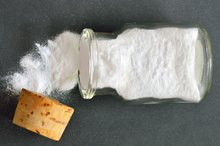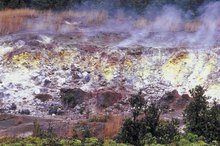Natural Sources of Calcium Hydroxide
Calcium is an essential mineral that is found in a variety of forms in nature. The various forms of calcium share an intimate chemical relationship with each other and the physical environment. These relationships are important in understanding the differences in the forms of calcium and how each form is used in food and traditional medicine production.
Portlandite
The various forms of calcium in the environment are constantly changing. However, when the correct conditions are induced, the result is the formation of the mineral portlandite 1. Portlandite is the naturally occurring form of calcium hydroxide 1. Portlandite is also formed during the curing of concrete 1. The most noted location of natural portlandite is in Northern Ireland, but calcium hydroxide is actually formed and used commonly for a variety of natural and chemical processes 1.
The Calcium Cycle
Foods Containing Calcium Propionate
Learn More
The most common form of calcium is found in the minerals calcite and aragonite, which make up the bulk of limestone deposits. These minerals are made up of calcium carbonate and are believed to form naturally from deposits of coral and oyster beds. When calcium carbonate is heated in a process referred to as burning or calcining, it forms calcium oxide, also known as quicklime. This reaction is reversible such that cooling the calcium oxide will change it back to calcium carbonate. If water is added to the calcium oxide, the process is termed slaking or hydration,and calcium hydroxide will form, also known as slaked-lime. Exposure to carbon dioxide will cause setting or carbonation of the calcium, which returns it to the form of calcium carbonate.
- The most common form of calcium is found in the minerals calcite and aragonite, which make up the bulk of limestone deposits.
- If water is added to the calcium oxide, the process is termed slaking or hydration,and calcium hydroxide will form, also known as slaked-lime.
Calcium Hydroxide and Food
Calcium hydroxide is a basic compound that is often used in the preparation of foods such as in the process of making corn tortillas. This process is known as nixtamalization, which literally translates from the Aztec language into “ashes” and “corn dough.” Traditional methods of producing calcium hydroxide include heating or burning pulverized oyster shells or bird egg shells, both high in calcium carbonate, and then adding the ashes to water to make a paste of calcium hydroxide 2. This paste is also used in Native American cultures to increase the bioavailability of other nutrients and plant alkaloids. The application of this process is still practiced in the preparation of corn dough for tortillas and tamales.
- Calcium hydroxide is a basic compound that is often used in the preparation of foods such as in the process of making corn tortillas.
- Traditional methods of producing calcium hydroxide include heating or burning pulverized oyster shells or bird egg shells, both high in calcium carbonate, and then adding the ashes to water to make a paste of calcium hydroxide 2.
Calcium Hydroxide and Traditional Medicines
Natural Source of Calcium Carbonate
Learn More
Traditionally prepared calcium hydroxide is also used in the preparation of various ethnobotanicals such as chewing tobacco, betel nut or coca leaves. The addition of calcium hydroxide ultimately increases the ability of the body to absorb certain compounds within the plant. In the case of corn, it allows for vitamin B3, or niacin, absorption. Niacin is important in reducing the incidence of pellagra, a disease characterized by diarrhea, dermatitis and dementia that can result from niacin deficiency.
- Traditionally prepared calcium hydroxide is also used in the preparation of various ethnobotanicals such as chewing tobacco, betel nut or coca leaves.
Related Articles
References
- Portlandite and Concrete
- Nixtamalization and Corn
- Pellegra
- Trailokya A, Srivastava A, Bhole M, Zalte N. Calcium and calcium salts. J Assn Physician India. 2017 Feb;65:100-3.
- National Institutes of Health. Calcium: Fact sheet for health professionals. Updated October 16, 2019.
- Shankar K, M S, Raizada P, Jain R. A randomized open-label clinical study comparing the efficacy, safety, and bioavailability of calcium lysinate with calcium carbonate and calcium citrate malate in osteopenia patients. J Orthop Case Rep. 2018;8(4):15-9. doi:10.13107/jocr.2250-0685.1138
- Ahmed A, Azim A, Gurjar M, Baronia AK. Hypocalcemia in acute pancreatitis revisited. Indian J Crit Care Med. 2016;20(3):173-7. doi:10.4103/0972-5229.178182
- Uwitonze AM, Razzaque MS. Role of magnesium in vitamin D activation and function. J Am Osteopath Assn. 2018 Mar;118:181-9. doi:10.7556/jaoa.2018.037
- Parva NR, Tadepalli S, Singh P, et al. Prevalence of vitamin D deficiency and associated risk factors in the US population (2011-2012). Cureus. 2018;10(6):e2741. doi:10.7759/cureus.2741
- Lamy O, Burckhardt P. Calcium revisited: part II calcium supplements and their effects. Bonekey Rep. 2014;3:579. doi:10.1038/bonekey.2014.74
Resources
Writer Bio
Dr. Bob Goat is a health and fitness writer. His research experience includes embryology, immunodiagnostics, genetic engineering and stem cells with expertise in gene and protein expression modification and embryonic development. He has had work published in academic journals, presented research at several national and international conferences and received numerous awards. He has a Ph.D. in medical science.









